Abstract
In view of the problems of traditional spraying technology, such as complex processes, high costs, large dust amounts, and poor air leakage effects, a new composite spraying slurry is proposed in this paper, which takes clay as the main base material and uses water pressure and wind pressure to ensure intrinsic safety. Firstly, the airtightness, bending resistance, and viscosity of the spraying material were measured in the laboratory; secondly, the gas–liquid–solid three-phase flow process involved in the spraying process was simulated by using the CFD-DPM method, adopting the Eulerian two-fluid model for continuous gas–water two-phases and the discrete phase DPM model for dust generation, and the transport, diffusion, and full space-time distribution characteristics of dust generation were studied. The research shows that: (1) the new composite slurry spraying material made of clay as the main material is made by adding a small proportion of cement and engineering fiber to increase the toughness of the material, and finally, determining the mass ratio of the composite material as follows: clay: cement: additive: engineering fiber = 84:14:1.85:0.15. It has good sealing and bending resistance and good adhesion; (2) the water phase distribution under the action of spray determines the distribution of solid-phase dust, and the distribution area of dust is similar to that of the water phase; (3) under the action of spray, the area at the bottom of the roadway is covered by dust flow, and the dust in this area is obviously stratified. The particle size of the dust gradually decreases from bottom to top. The large particle size dust is deposited at the bottom, while the small particle size dust is suspended at a certain height, and the diffusion area gradually increases; (4) the effect of spray angle on dust is mainly manifested in the initial dust flow shape and dust diffusion time. The larger the spray angle, the faster the diffusion; (5) when the water velocity at the nozzle outlet is large, the dust concentration is low in the whole area, but in areas higher than 1.5 m, the PM2.5 concentration also increases with the increase in water flow. The dust suppression effect of larger a water flow is mainly reflected in the bottom area, and the disturbed surrounding airflow can make PM2.5 diffuse to higher areas.
1. Introduction
More than 90% of China’s coal mines are facing a major threat of mine fire in the process of mining. Among them, coal spontaneous combustion is the main disaster in the process of coal safety production, which usually occurs in the air leakage channel areas, such as goafs, open ditches, production lines, geological structure zones, etc [1,2]. In addition, in many high gas mines, the development of coal pillar fractures will produce gas leakage channels between the roadways of the mining face and the adjacent goafs, which can easily cause an increase in gas concentration in the upper corner of the coal mining face or driving face, resulting in a gas overrun, affecting coal mine safety production and increasing the difficulty of mine ventilation, gas prevention, and control.
Leakage-proof wind energy can effectively reduce the risk of coal spontaneous combustion. The existing sealing and air leakage prevention methods include coating technology, reducing the pressure difference on both sides of the coal wall, and blocking air leakage cracks with polyurethane foam and organic curing foam [3]. However, due to its small workload and high efficiency, spraying technology is widely used in coal mine roadway air leakage prevention in China [4,5]. Spraying can reduce air leakage in roadways, prevent the low temperature oxidation of broken coal, and minimize coal spontaneous combustion in goafs and roadway caving areas. Spraying coal pillars can prevent the development of coal wall cracks, weaken coal wall oxidation, and ensure regional safety mining. At present, the traditional methods of spraying to block air leakage in mines mainly include foam resin spraying, concrete spraying, fly ash filling, etc. [6,7,8,9,10]. However, it is not suitable for the process of resin spraying, and it is not suitable for the operation of resin spraying. The concrete has a good air blocking ability and a strong compression resistance, but the dust generated in the spraying process is large, the coating rebound is large, and the transportation cost of sand, cement, and other materials is high. The fly ash filling technology often needs to arrange boreholes on the side of the roadway, which make the roadway have more cracks after filling, so the effect of blocking the air leakage is not good [11,12,13,14,15,16].
Therefore, in view of the problems such as complex processes, high costs, large amounts of dust, and poor air leakage effects of the traditional spraying technology, this paper proposes to use a new type of composite spraying slurry with clay as the main base material and water pressure and wind pressure to ensure intrinsic safety. Based on the CFD-DPM method, the Eulerian two-fluid model was used to simulate the gas phase and water phase, and the Lagrangian model was used to track dust particles, the influence of spray technology on the dust diffusion, and the distribution in the spraying process. The whole process of dust diffusion under the two variable working conditions of spray flow and spray angle was studied. The distribution laws of dust with different particle sizes, especially PM2.5, were statistically analyzed, providing theoretical support for reasonable dust reduction and optimization of spray parameters in the spraying process.
2. Performance Analysis of a New Composite Spraying Slurry
On the basis of clay as the main material, a small proportion of cement and engineering fiber are added to increase the toughness of the material. Through comparative analysis, the final mass ratio of the composite material is Clay: cement: additive: engineering fiber = 84:14:1.85:0.15.
Compared with the traditional cement mortar spraying technology, the main material of the spraying material is changed from cement to clay. Combined with the air leakage situation of the tunnel walls, the air tightness, bending resistance, and viscosity of the material are tested.
(1) Air tightness analysis of paste materials
In the mercury injection experiment, in order to overcome the internal surface tension, a certain pressure p needs to be provided before filling the pores with radius R. For cylindrical pores, p and R need to meet the Washburn relationship, as follows:
where σ is the surface tension of mercury and ϴ is the contact angle between mercury and solid.
Through the analysis of the experimental data, the specific gravity and porosity of the slurry are shown in Table 1, the pore surface area and the distribution percentage of different types of slurry materials are shown in Table 2, and the volume and distribution percentage of different types of pores are shown in Table 3. According to Table 1, the porosity of the paste material is 32.71%; according to Table 2, the total surface area of micropores, pores, and mesopores accounts for 99.06% of the total surface area of pore structures, and the proportion of mesopores is close to 50%. It can be seen from Table 3 that in the basic distribution of the micropore structure of paste materials, the mesoporous pore (1.0 × 10−4~1.0 × 10−3 mm) volume accounted for 75.82%.

Table 1.
Determination results of specific gravity and porosity of paste materials.

Table 2.
Surface area and distribution percentage of different types of pores.

Table 3.
Different types of pore volumes and their distribution percentages.
The results show that the porosity of the slurry is 32.71%. The sum of the surface areas of the micropores, pores, and mesopores accounted for 99.06% of the total surface area of the pore structure, and the sum of their volumes accounted for 79.16% of the total pore volume.
The microfractures are characterized by the development and change from micropore to mesopore (pore size ≤ 1.0 × 10−3 mm), which accounted for the majority of the paste materials, accounting for more than 80%. The coarse, large pores and fractures are not developed, and the actual proportion is relatively small.
According to the above conclusions, the slurry material is compact in structure and has good air tightness. However, the static pressure difference between the two sides of narrow coal pillars is generally less than 500 Pa, and the slurry material selected can basically block the airflow and prevent gas emission near the goaf.
(2) Analysis of the bending resistance of the slurry
A 15 cm × 40 cm acrylic plate is used to glue the broken coal blocks with different particle sizes on it. After standing for one day, an experimental wall similar to the tunnel wall was obtained, as shown in Figure 1a. The slurry material was sprayed on the experimental wall of the roadway and left for 15 days, as shown in Figure 1b. A bending test was carried out on the spraying material, as shown in Figure 2. When obvious cracks appeared on the spray coating surface (as shown in Figure 3), the bending test was stopped. When there were obvious cracks, the arc length was 40 cm, the angle was 70°, and the bending radius was r = 32.75 cm. The curvature of the experimental plate was ρ = 1/r = 0305 = 3.05%. The highest point of the arc was 5.92 cm higher than that before bending ε = 5.92/40 = 14.81%.

Figure 1.
Wall bending model of a coal seam roadway: (a) simulated wall; (b) simulated spray coating.
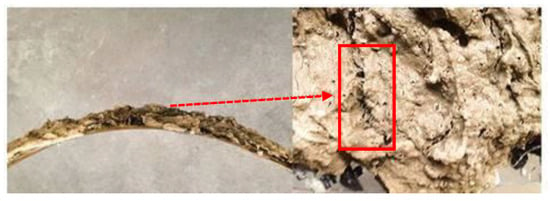
Figure 2.
Bending effect of the simulated experimental plate of coal a seam roadway wall.

Figure 3.
Curvature calculation of the simulated experimental plate of a roadway wall.
According to the experimental results, after the deformation of the underground roadway, the local area will produce bending deformations. When the bending curvature reaches about 3.05% or the ratio of the distance between the starting point of the local area and the horizontal distance of the overall deformation area is close to 14.81%, the spraying material will crack obviously, which may produce gas emission channels.
(3) Viscosity analysis of the slurry
At normal temperatures, the viscosity of the wetted paste was measured by a mcr102 rheometer. Based on the different proportions of water, the shear frequency is 60 s−1. Five groups were measured; each group was measured three times, and the average value was taken. The measurement curve is shown in Figure 4. It can be seen from Figure 4 that the viscosity of the paste material decreases with the increase in the water ratio.
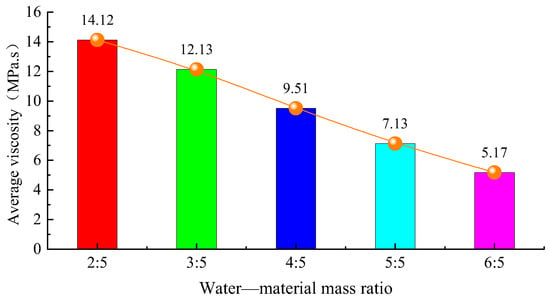
Figure 4.
Viscosity measurement curve.
3. Selection of the Two-Fluid Model and Calculation Parameters
3.1. Selection of the Two-Fluid Model
As shown in Figure 5, the slurry spraying process belongs to a typical three-phase flow. The feeding module continuously inhales the slurry base material particles into the spraying operation system through the negative pressure generated by the pneumatic suction device. After fully mixing the atomized water on the spray gun mouth and the nozzle, it moves to the spraying surface under the action of inertia.
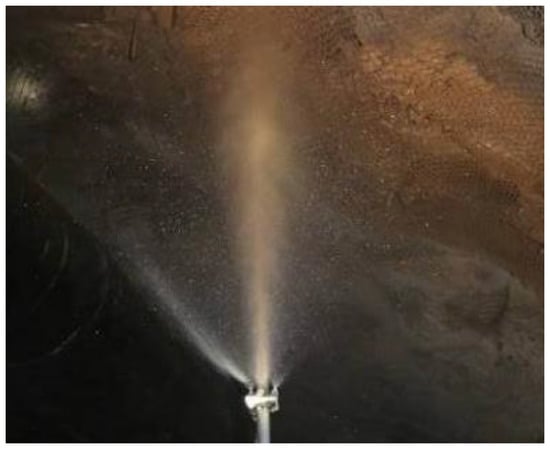
Figure 5.
Schematic picture of the spraying process.
Based on the CFD-DPM method, the Eulerian two-fluid model is used to simulate the gas and water phases, and the Lagrange model is used to track dust particles. The dust migration process under various working conditions is studied, and the three-phase flow is analyzed in detail. The water spray and surrounding air belong to a continuous phase, and the Euler–Euler two-fluid model is used to simulate. The base material of the slurry belongs to a discrete particle phase, and the DPM model is used to track and simulate.
The particle size distribution of industrial dust is not uniform; it is randomly distributed, but the industrial dust particle size distribution generally presents certain regularity. The commonly used particle size distribution functions generally include the normal distribution, the logarithmic normal distribution, and the Rosin–Rammler distribution function.
The particle size distribution used in this paper is shown in the figure below, and the average particle size was taken as d = 100 μm. The particle distribution index n = 3.5, and the dust particle size distribution is shown in Figure 6.
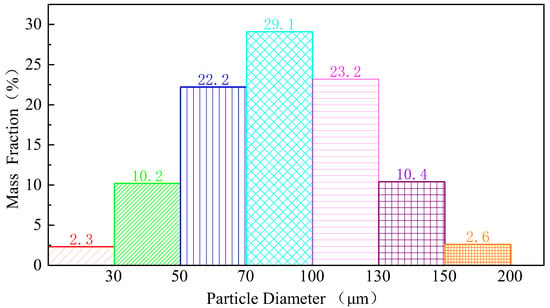
Figure 6.
Particle size distribution table.
As shown in Figure 6, the dust distribution basically presents a normal distribution, and the dust particle size is mostly concentrated below 150 μm.
3.2. Calculation Conditions and Parameters
In order to focus on discussing the dust generation and its distribution characteristics in the slurry spraying process, the actual situation is simplified as follows: the heat transfer between the air and the slurry is not considered in the numerical calculation of the spray dust generation process; that is, the related flow problems are studied under cold conditions. The overall model structure is shown in Figure 7a, and the simplified physical model diagram is given. The structured grid is adopted, and the grid opposites are verified, as shown in Figure 7b.

Figure 7.
Local roadway structure: (a) physical model; (b) grid structure.
The spraying process of slurries belongs to a typical three-phase flow. Based on the CFD-DPM (computational fluid dynamics discrete particle method), this paper uses the Eulerian two-fluid model to simulate the gas phase and water phase and uses the Lagrangian model to track the dust particles to study the dust migration process under various working conditions. Among them, the water spray and the surrounding air belong to the continuous phase, and the Euler–Euler two-fluid model is used for simulation research; the base material of the slurry belongs to the discrete particle phase, and the DPM model is used for tracking and simulation calculation. See Table 4 for the two-fluid model and the related parameters and Table 5 for the DPM model and the related parameters.

Table 4.
Two-fluid model and the related parameters.

Table 5.
DPM model and related parameters.
In order to discuss the dust production in the process of slurry spraying, the local roadway is taken as the research object. The length of the roadway is 3 m, the width is 4 m, and the distance between the vault and the ground is 4 m. Combined with the actual situation, the following physical model is simplified: the roadway is full of air, and there is airflow in the horizontal direction (along the x axis). The spray gun is perpendicular to the airflow direction and placed horizontally. The base material is ejected from the central nozzle. The diameter of the spray gun is about 0.03 m, and the length is 0.5 m. There are four nozzles around the nozzle for spray atomization.
4. Migration and Distribution Characteristics of Dust Produced in the Spraying Process
4.1. Dust Distribution with or without Spray
The particle size range of the dust was 2 × 10−6~3 × 10−4 m. In order to observe the temporal and spatial distribution changes of the dust, when the dust is visualized, the dust should be enlarged to the appropriate size so that the spatiotemporal distribution information of dust with different particle sizes can be obtained intuitively.
- (1)
- Dust distribution without spray
When the velocity of the spray gun is lower than that of the spray gun, there is no dust in the exit of the tunnel. Due to the continuous outflow of dust from the spray gun, the dust gradually increases so that the cross-section of the dust mainstream increases gradually during the dust migration until it flows out from the outlet, as shown in Figure 8.

Figure 8.
Distribution and variation of dust without spraying and the spray gun outlet pressure.
With the increase in the initial velocity of the base material ejected from the spray gun, the dust generated will move to the side under the action of inertia and diffuse around at the same time. With the continuous outflow of dust from the spray gun, the amount of dust increases gradually, and the dust diffusion area also gradually increases, as shown in Figure 9. At the same time, due to the influence of transverse airflow in the roadway, there is more dust at the downwind side; the amount of dust on the side where the spraying surface is located gradually increases, and the diffusion area gradually extends to the surrounding area, as shown in Figure 9 (t = 0.6 s). At this time, the dust has diffused to the bottom and top areas of the spraying side. The distribution of dust with different particle sizes (i.e., different colors in the figure) is different. For example, the top area is mostly fine dust (blue and green particles), and the large particle size dust is relatively small (red particles). The dust continues to diffuse under the action of airflow. With the increase in dust production, the diffusion area continues to increase until it diffuses to the whole calculation area; see t = 1.0 s. The dust has diffused to the whole roadway calculation area. With the continuous spraying process, more and more dust is in the whole calculation area, and the visibility gradually decreases until t = 20.0 s. At this time, the spraying is stopped; that is, the dust is no longer produced at the dust source. Under the carrying effect of the transverse airflow, the dust in the roadway area is gradually discharged from the outlet, the dust particles are rapidly reduced, the dust concentration is gradually reduced, and the visibility is also gradually improved.
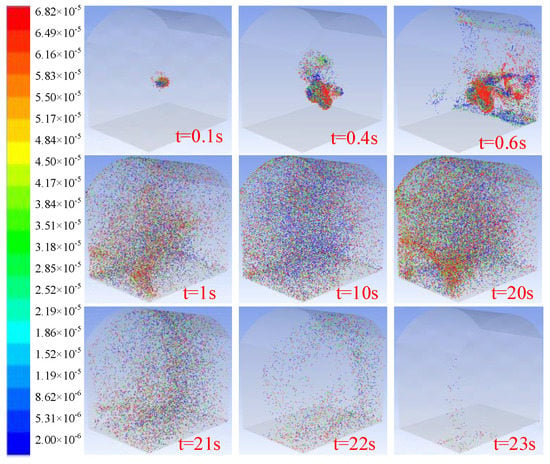
Figure 9.
Distribution and change of dust without spraying and with a high spray gun outlet pressure.
- (2)
- Dust distribution with spray
When there is spray, the dust generation is directly affected by the surrounding four water mist streams and is forced to flow with the water mist to the side wall; see t = 0.10 s in Figure 10. With the spraying process going on, the dust production gradually increases; see t = 0.6 s. Under the action of water mist, the generated dust flows to and reaches the side wall and diffuses on the side wall; see t = 1.0 s. At this time, there are more red particles at the bottom and more blue-green particles at the top. This shows that the dust is gradually stratified in the flow process, and the large particle size dust tends to deposit, while the small particle size dust easily diffuses to the high places.
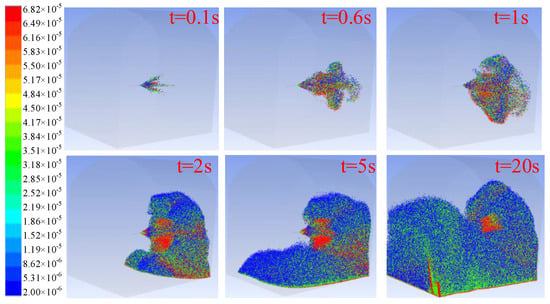
Figure 10.
Distribution and change of dust with spray and high spray gun outlet pressure.
Due to the blocking effect of the side wall, the water generated in the spraying process will carry the dust to the ground and then flow along the ground to the opposite side, as shown in Figure 10. As a result, the dust carries downward to the opposite side. At the same time, affected by the transverse airflow in the roadway, the water mist diffuses to the opposite side and the outlet direction at the same time. The dust also diffuses to the opposite side and the outlet side under the carrying effect of the water mist. See T = 2.0 S in Figure 10.
The bottom area of the roadway has been covered by the dust flow. In this area, from the bottom up, it gradually changes from red particles to green particles, and then to a blue-green mixed particle area, while the top has more blue particles and fewer green particles. It can be seen that the dust stratification is obvious; the large particle size dust is deposited at the bottom, while the small particle size dust is suspended at a certain height. Compared with the simulation results in Figure 9 and Figure 10, compared with the case without spray, the dust is mainly distributed in the bottom area under the action of water mist, and the effect of the spray dust reduction is obvious. The distribution of dust with large and small particle sizes changes under the action of spray, and the dust with a large particle size is easier to settle under the action of gravity. In Figure 10, no fine dust diffuses to the top area, which shows that the spray can effectively inhibit the diffusion of fine dust in the height direction.
As shown in Figure 11, the distribution of dust under spray is closely related to that of the water phase. Taking the vertical and horizontal section of the central point of the calculation area as an example, the water phase distribution in the gas–liquid–solid three-phase is analyzed, and its development with time and space is observed. After the water mist is ejected from the nozzle, it carries the dust diameter directly to the spraying wall under the inertial action, which is blocked by the spraying wall, and forms a mist area with a large water phase concentration near the spraying wall. Under the action of gravity, the mist will flow to the bottom of the roadway and diffuse along the opposite side of the spraying surface. After the non-spraying surface, the diffusion area starts to extend upward, thus forming a relatively continuous mist area with a small water compatibility and a small gradient on the two sides and bottom of the roadway.
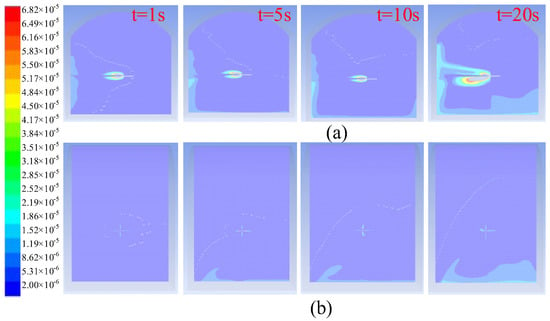
Figure 11.
Concentration distribution of the aqueous phase. (a) Cross section (width direction); (b) Longitudinal section (length direction).
Compared with the solid-phase dust distribution map of T = 20.0 s in Figure 10 and the water phase diagram in Figure 11a, it can be seen that the distribution area of dust is similar to that of the water phase, mainly distributed on the two sides and near the bottom of the roadway. In addition, under the action of transverse airflow in the roadway, the thin water mist will flow from the inlet side to the outlet side under the action of the airflow. The water volume at the outlet side is obviously more than that at the inlet side, as shown in Figure 11b. The dust in the outlet side is also more than that in the air-inlet side, as shown in the solid-phase dust distribution diagram with T = 5.0 s in Figure 10. This shows that the distribution of the solid phase can determine the effect of the water spray. The dust concentration on the site of the new spraying process and the traditional spraying process is significantly reduced, as shown in Figure 12.
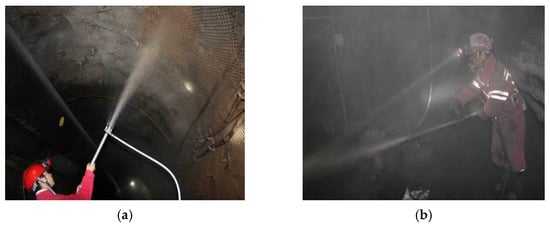
Figure 12.
Comparison of dust concentration on site between the traditional spraying process and the new spraying process: (a) site environment of the new spraying process; (b) site environment of the traditional spraying process.
4.2. Temporal and Spatial Distribution of Dust
- (1)
- Temporal and spatial distribution of total dust
Under the working conditions of a spray angle of 70°, a material suction of 0.038 kg/s, a side air velocity of 0.5 m/s, and a water spray rate of 11 L/min, the dust migration process in the spraying process is simulated and the spatial and temporal distributions are as shown in Figure 13.

Figure 13.
Dust distributions in different directions.
As shown in Figure 13, the dust concentration gradually decreases along the length direction. The dust concentration in most areas is less than 10 mg/m3. The dust concentration is higher in the downwind side, especially near the exit. With the increase in spraying time, the dust concentration on the downwind side increased significantly. Among them, 1.5 m is the location of the spray gun, which is the dust source, and the dust concentration is slightly higher than in other areas. The distribution of the dust concentration in the width direction showed a trend of being high at both ends, and in the middle of the dust source, the dust concentration increased. The width of 4.0 m corresponds to the sprayed wall, and the dust concentration near the wall increases with the spraying time. When the width is 0.0 m, the growth rate of the dust concentration is far greater than that of the sprayed side. This is mainly the result of spray, airflow, and wall obstruction. The dust concentration decreases with the increase in height, especially in the area near the ground (below 0.4 m). This shows that the dust, especially the dust with a large particle size, is mainly distributed in the bottom area of the roadway. In the area above 0.5 m, the rate of decrease in the dust concentration is greatly reduced, and it is all lower than 5 mg/m3 and only slightly increased at the height of 1.5 m. There is almost no dust in the area above 2.0 m, and its concentration tends to 0. It is further explained that, compared with the case without spraying, spraying can effectively inhibit the dust diffusion in the height direction.
- (2)
- Dust distribution with different particle sizes
From the above analysis, it can be seen that the dust concentration decreases with the increase in height. Considering the different dust diffusion capacities of different particle sizes, three particle size ranges of PM2.5, PM40–100, and PM50–100 are selected to investigate the distribution and changes of the three groups of dust in the height direction, as shown in Figure 14a.
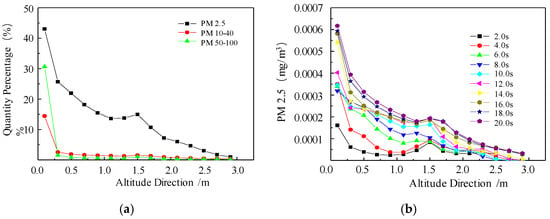
Figure 14.
Distribution of dust with different particle sizes in the height direction: (a) three groups of dust; (b) PM2.5.
Considering that the mass concentration of PM2.5 is relatively small (<0.001 mg/m3), as shown in Figure 14b, the quantitative percentages of the three groups of dust at different heights are counted here, and it is found that the percentage of PM2.5 is relatively large, more than 40% in the bottom area. In addition, the number percentage of PM2.5 is large in the whole height direction, indicating that PM2.5 has strong diffusion ability in the height direction, and its concentration gradually decreases along the height direction, only slightly increasing at 1.5 m of the dust source (>15%). In contrast, the concentration of dust with a medium particle size, namely PM40–100, is relatively small, and it is almost 0 in areas higher than 2.0 m. For large particle size dust, the number percentage decreases significantly near the wall, indicating that the large particle size dust is mostly concentrated at the bottom. It can be seen from Figure 14b that the initial concentration of PM2.5 dust with a small particle size is very small, lower than 0.0002 mg/m3, and no PM2.5 is found in the top area. With the spraying process, the mass concentration of PM2.5 in the top area also gradually increases.
4.3. Influence of the Spray Angle of the Water Mist
- (1)
- Temporal and spatial distribution of the total dust
The spray angle is defined as the angle between the direction of the water jet and the cross-section of the outlet. In this paper, under the conditions of 0.038 kg/s of suction, 0.5 m/s of side air supply, and 11 L/min of water spray, three working conditions of 58°, 64°, and 70° are selected to simulate and calculate, and the temporal and spatial distribution of the dust is analyzed. The temporal and spatial distribution of the dust is shown in Figure 15, Figure 16 and Figure 17. The results show that at the initial moment, the influence of the water jet angle on the dust flow is obvious. The larger the jet angle is, the smaller the water mist area formed by the four water jets is.
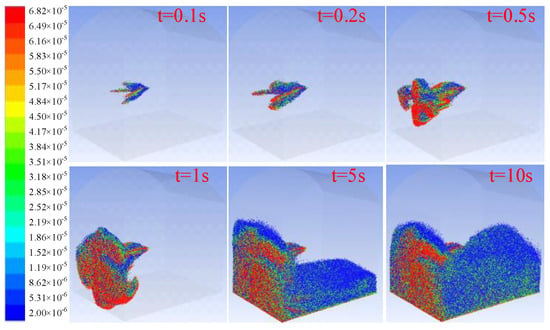
Figure 15.
Temporal and spatial distribution of the total dust under a 70° injection angle.

Figure 16.
Temporal and spatial distribution of the total dust at a 64° injection angle.
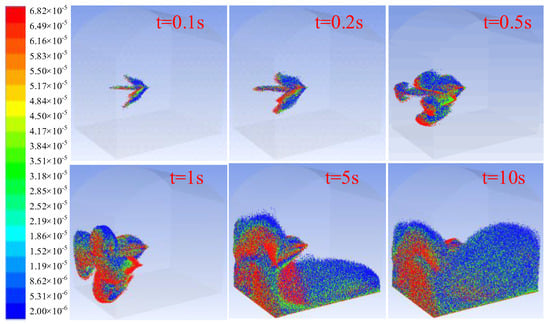
Figure 17.
Temporal and spatial distribution of the total dust at a 58° injection angle.
Due to the different spray angles, the velocity of the water jet perpendicular to the spraying surface is different. When the spraying angle is 70°, the velocity perpendicular to the spraying surface is larger, so the time for water carrying dust to reach the spraying surface is shorter, and the dust diffusion to the surrounding area is faster.
In order to explore the influence of the different spray angles of water mist on the dust distribution, the total dust distribution along the length and width of the roadway was calculated, as shown in Figure 18.
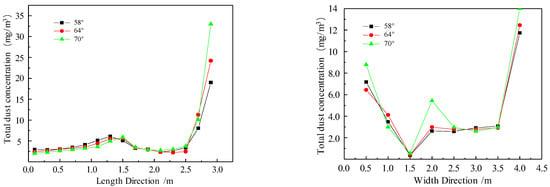
Figure 18.
Total dust distribution in different spray angles and directions.
- (1)
- In the length direction, the dust flows out from the air supply outlet to the outlet, and its concentration gradually increases to 5 mg/m3 (dust source location). Then, the dust concentration gradually decreases and increases rapidly near the outlet.
- (2)
- In the width direction, the dust concentration on both sides of the wall is higher, and the dust concentration near the spraying surface is significantly higher than that of the non-spraying surface. At the same time, the dust concentration near the two sides is larger when the spraying angle is 70°.
- (3)
- PM2.5 distribution
As shown in Figure 19, the distribution of the PM2.5 concentration under different injection angles is obtained by taking PM2.5 as an example in the height direction. The concentration of PM2.5 decreased with the increase in height and fluctuated slightly at the position of the 1.5 m dust source. In the height range of 0.4 m to 1.5 m, the concentration of PM2.5 increased with the increase in injection angle. This is because when the spray angle is larger, the vertical velocity of the spray surface is larger, so the water carries the dust movement faster and the dust diffusion speed is faster. The diffusion rate decreases gradually along the way, so the injection angle has little effect on the PM2.5 concentration in the area higher than 1.6 m. This shows that the influence of the spray angle changes on PM2.5 diffusion is mainly in the initial stage and the middle and lower regions.
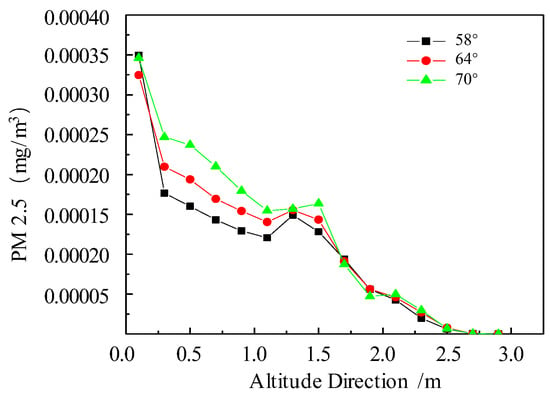
Figure 19.
Distribution of PM2.5 in different spray angles and directions.
4.4. Effect of Spray Water Velocity
- (1)
- Temporal and spatial distribution of the total dust
When the spray angle is 58 degrees, the suction rate is 0.038 kg/s, the side air supply is 0.5 m/s, and the water spray rate is 3.0 L/min, 7.4 L/min, and 11.0 L/min, respectively; the dust spatial and temporal distribution is analyzed. The temporal and spatial distribution of the dust is shown in Figure 20.
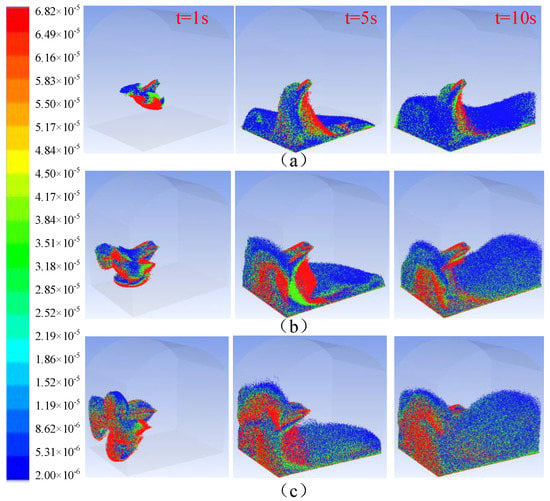
Figure 20.
Temporal and spatial distribution of the total dust under different spray water velocities. (a) 3.0L/min; (b) 7.4L/min; (c) 11.0L/min.
It can be seen from Figure 20 that when the water velocity at the nozzle outlet is large, the surrounding airflow is also driven. Under the action of fast velocity, the dust diffuses rapidly in the roadway area. When the diffusion rate is t = 1.0 s, the growth is the fastest. At t = 5.0 s, comparing the dust distribution map of the three groups of flow, it can be found that the velocity of dust migration to the spraying surface is slow due to the low velocity. In the process of migration, due to the different particle sizes and the different gravity and fluid-carrying effects, there is an obvious stratification phenomenon. For example, when t = 1.0 s in Figure 20a and T = 5.0 s in Figure 20b, there is more red dust with a larger particle size in the lower area of the nozzle frontend. When t = 5.0 s in Figure 20b, the particle size of the dust gradually decreases from right to left, followed by red dust, green dust, and blue dust. This shows that when the water velocity at the nozzle outlet is small, the water flow carrying effect is limited, and the large particle size dust easily separates from the dust flow under the action of gravity and gradually settles to the bottom.
When the water velocity at the outlet of the nozzle is large, the phenomenon of stratification also exists, as shown in Figure 20c, but it is not as obvious as that when the water velocity at the outlet of the nozzle is small. At t = 10.0 s, comparing the dust distribution map of the three groups of flow, it can be found that when the velocity is high, the dust diffuses rapidly in the bottom area of the roadway, and the diffusion space is also large.
As shown in Figure 21, the distribution of dust along the length, width, and height of roadway is counted under different water velocities at the nozzle outlet. When the nozzle outlet water velocity is large, the dust concentration is low in the length, width, and height directions; that is, when the nozzle outlet water velocity is large, the dust concentration is low in the whole calculation area. As shown in Figure 21a, when the nozzle outlet water velocity is small, the dust diffusion is slow, and the dust distribution in the length direction is not stable. In addition to the high concentration at the dust source position, a high concentration area also appears in the front of the outlet. When the nozzle outlet water velocity is large, the dust distribution in the length direction is more than 5 mg/ m3. The dust concentration near the dust source and outlet increases rapidly. Compared with the nozzle outlet water of 7.4 L/min, the dust concentration near the outlet of 11.0 L/min is lower.

Figure 21.
Total dust distribution in different directions: (a) length direction; (b) width direction; (c) altitude direction.
As shown in Figure 21b, from the dust concentration distribution in the width direction, the dust concentration is generally high when the outlet water flow is small. When the outlet water flow rate is small, the dust concentration on the opposite side of the spraying surface exceeds that on the spraying side, which indicates that more dust is separated from the main stream along the way, depositing and diffusing. However, when the outlet flow is large, the dust concentration is relatively low in the whole width direction.
As shown in Figure 21c, the dust concentration decreases rapidly in the near-ground area, then decreases slowly with the increase in height and only slightly increases at the height of the dust source. When the dust concentration is higher than 1.5 m, the dust concentration under the three working conditions almost tends to 0. In addition, the decreasing speed of the dust concentration in the bottom area decreases with the increase in water flow.
- (2)
- Temporal and spatial distribution of PM2.5
Taking PM2.5 as an example, the change of the PM2.5 concentration under different water flow conditions was observed. The measurement results are shown in Figure 22. The results show that the concentration of PM2.5 decreases with the increase in water flow in the area below 0.7 m. For the area higher than 1.5 m, the concentration of PM2.5 also increases with the increase in water flow, which indicates that a larger water flow can effectively suppress dust, mainly in the bottom area. At the same time, the larger water flow intensifies the disturbance of the surrounding airflow, and the disturbed airflow carries dust diffusion, which makes the dust such as PM2.5 spread to a higher area.
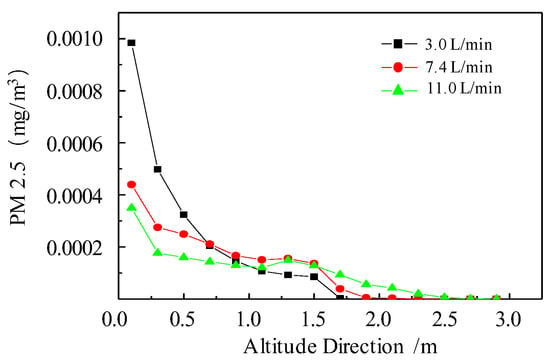
Figure 22.
Distribution of PM2.5 in the altitude direction.
5. Conclusions
- (1)
- The composite spraying slurry with clay as the main base material has a good sealing performance, certain bending resistance, and good adhesion, which can be used for the air leakage plugging technology of spraying in roadways.
- (2)
- The distribution of solid dust is determined by the distribution of the water phase under the action of spray. The distribution area of dust is similar to that of the water phase, mainly at the two sides and near the bottom of the roadway. Compared with the non-spray condition, the effect of the spray dust reduction is obvious.
- (3)
- Under the action of spraying, the bottom area of the roadway is covered by dust flow, and the dust stratification phenomenon is obvious in this area. The dust particle size gradually decreases from the bottom to the top, and the large particle size dust is deposited at the bottom, while the small particle size dust is suspended at a certain height; the diffusion area is gradually increased.
- (4)
- The influence of spray angle on dust is mainly reflected in the initial dust flow shape and dust diffusion time. The larger the spray angle is, the faster the diffusion is. The influence of spray angle on the diffusion of dust, especially PM2.5, is mainly concentrated in the middle and lower regions.
- (5)
- When calculating the velocity, the dust concentration is larger in the whole nozzle area. However, in the area higher than 1.5 m, the concentration of PM2.5 increases with the increase in water flow, which indicates that the dust suppression effect of a larger water flow is mainly reflected in the bottom area, and the disturbed surrounding airflow can make PM2.5 diffuse to higher areas.
Author Contributions
Conceptualization, S.S. and C.L.; writing—original draft, C.L.; data curation, C.L.; formal analysis, C.L.; methodology, C.L. and S.S.; project administration, S.S.; conceptualization, S.S.; resources, C.L., X.S., Z.Z. and Z.S.; investigation, X.S.; supervision, X.S.; visualization, Z.Z.; validation, Z.S.; writing—review and editing, B.Z.; software, B.Z.; funding acquisition, B.Z. All authors have read and agreed to the published version of the manuscript.
Funding
This research received no external funding.
Data Availability Statement
The Microsoft Excel Worksheet data used to support the findings of this study are available from the corresponding author (18342833697@163.com) upon request.
Conflicts of Interest
The authors declare no conflict of interest.
References
- Wang, D.M. Mine Fires; China University of Mining and Technology Press: Xuzhou, China, 2007. [Google Scholar]
- Xian, X.F.; Wang, H.T.; Jiang, D.Y.; Liu, B.X. The summarization of the investigation on coal mine fire prevention & fire extinguishing techniques in China. Eng. Sci. 2001, 12, 28–32. [Google Scholar]
- Zhou, F.B.; Shi, B.B.; Liu, Y.K.; Song, X.L.; Cheng, J.W.; Hu, S.Y. Coating material of air sealing in coal mine: Clay composite slurry (CCS). Appl. Clay Sci. 2013, 80–81, 299–304. [Google Scholar] [CrossRef]
- Yao, J.; Wang, X.; Tian, D.; Zhang, Q. Experimental study on the performance of phosphogypsum and fly ash cemented filler. Min. Res. Dev. 2006, 26, 44–48. [Google Scholar]
- Luo, Z.; Deng, J.; Yang, Y. Study on properties of hydrogel sealing filling material in underground disaster areas. J. China Univ. Min. Technol. 2007, 36, 748–751. [Google Scholar]
- Wang, S.; Wu, H. Application of new polymer grouting material Malisan in water plugging and shaft wall reinforcement of Wangfenggang No. 1 auxiliary shaft. Friends Chem. Ind. 2007, 1, 40–42. [Google Scholar]
- Li, A.; Long, W. Experimental study on light quick setting plugging material. Concrete 2003, 4, 33–34. [Google Scholar]
- Hu, C.; Yu, S.; Wang, H. Application of new polymeric materials in prevention and control of spontaneous combustion. Coal Mine Saf. 2003, 34, 35–36. [Google Scholar]
- Sun, G.; Liu, Y.; Feng, F.; Sun, H.; Bian, K.; Hu, K. Research progress of polyurethane foam. Mater. Guide 2006, 20, 29–36. [Google Scholar]
- Chen, J.; Wang, Z.; Fan, P.; Wang, X. Application of fly ash in underground filling of Xinqiao Pyrite Mine. Met. Mines 2001, 8, 36–38. [Google Scholar]
- Fan, W.; Geng, Y.; Han, J.; Wang, Y. Study on Parameter Optimization of high performance shotcrete. J. Coal 1999, 24, 481–484. [Google Scholar]
- Nie, W.; Zhang, Q.; Bai, R.; Yu, H.; Ma, X.; Liu, W. Numerical simulation of airflow dust transport law in roadway wet spraying operation. J. Saf. Environ. 2015, 15, 73–77. [Google Scholar]
- Zhou, G.; Zhang, Q.; Cheng, W.; Chen, L.; Feng, K.; Nie, W. Numerical simulation of shotcrete dust in coal mine anchor shotcrete operation area and development of a new wet shotcrete integrated machine. J. Cent. South Univ. (Nat. Sci. Ed.) 2016, 47, 606–614. [Google Scholar]
- Guo, J.; Shen, H.; Sun, M.; Liang, Z. Internal flow field analysis of a new ejector. Fluid Mach. 2009, 37, 25–28. [Google Scholar]
- Zhang, B.; Zhou, H.; Chang, Q.; Zhao, X.; Sun, Y. The Stability Analysis of Roadway near Faults under Complex High Stress. Adv. Civ. Eng. 2020, 2020, 8893842. [Google Scholar] [CrossRef]
- Lu, Z.; Lei, Z.; Nadeem, Z.M. Synthesis and performance characterization of an efficient environmental-friendly Sapindus mukorossi saponins based hybrid coal dust suppressant. J. Clean. Prod. 2021, 306, 127261. [Google Scholar] [CrossRef]
Publisher’s Note: MDPI stays neutral with regard to jurisdictional claims in published maps and institutional affiliations. |
© 2022 by the authors. Licensee MDPI, Basel, Switzerland. This article is an open access article distributed under the terms and conditions of the Creative Commons Attribution (CC BY) license (https://creativecommons.org/licenses/by/4.0/).